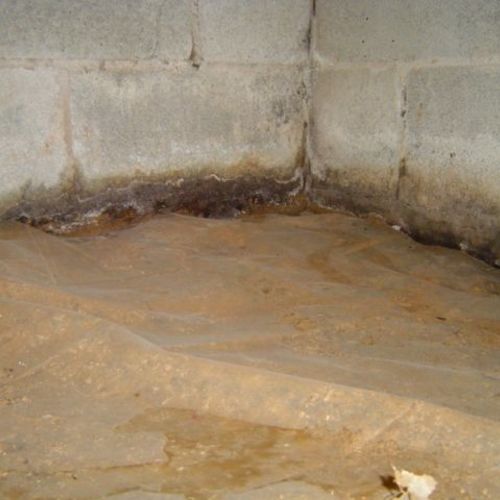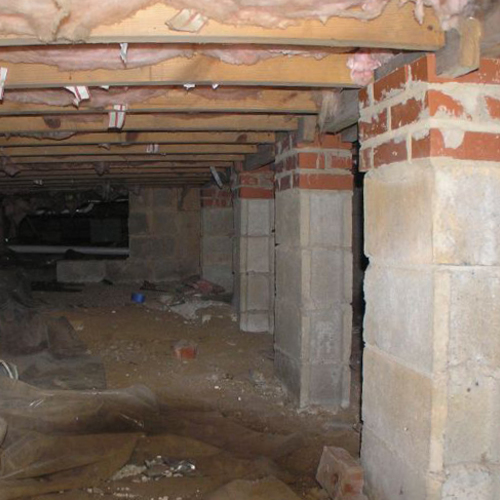
There are at least two things worth nothing about the house that Satinder is building in climate zone 4A.
“I am building a house in flood zone over a crawlspace that has flood vents,” he writes in this recent Q&A post. “It has already been constructed with a poured concrete foundation and a 3-inch concrete floor over a vapor barrier.” (Flood vents are designed to equalize hydrostatic pressure in flood zones; for more see this FEMA bulletin.)
Drains have been installed below the concrete slab, and the crawlspace also has a sump pump and a radon mitigation system. Satinder’s concern is how to insulate and air-seal the crawlspace to prevent cold floors in the rooms above, and to prevent air leakage into the living area.
An insulation contractor is recommending 3 inches of closed-cell spray foam on the crawlspace ceiling, plus 2 in. of foam over the rim joists. That would provide almost R-20 worth of insulation in the crawlspace ceiling and another R-13 on the rim joists.
“Is this going to be enough to separate the crawlspace from my living space from temperature fluctuations?” Satinder asks. “Is this going to create any issues with water condensation during summer since it gets quite humid where I am.”
Those concerns are where we start this Q&A Spotlight.
Is spray foam the best option?
Closed-cell spray polyurethane foam has advantages. In addition to high R-value per inch, it also blocks the passage of water vapor, and it’s a very effective air barrier. Does that make it the best choice here, as Satinder’s contractor is suggesting?
Not necessarily, says Steve Knapp. He refers Satinder to an article from Fine Homebuilding on insulating this type of assembly, and points out that there are ways of insulating cold floors that…
Weekly Newsletter
Get building science and energy efficiency advice, plus special offers, in your inbox.

This article is only available to GBA Prime Members
Sign up for a free trial and get instant access to this article as well as GBA’s complete library of premium articles and construction details.
Start Free TrialAlready a member? Log in














3 Comments
I've had great success in coastal NJ (Zone 4) using Flood Flaps for flood vents. These are made of rubber, with the flexible flap setting in a groove in the frame. When closed, they are nearly airtight. When exposed to water pressure from inside or outside, the flaps pop out of the groove and allow water and/or airflow. They do have to be reset after flood events. They are available with double flaps that maintain a dead-air space between them for some insulating value. Adding a friction-fit block of EPS foam to the openings makes them somewhat better for heat loss when the perimeter walls are insulated with rigid foam. The friction-fit foam will blow out during the dynamic pressure loading during a flood event.
I've never worried too much about air pressurizing the crawl during a flood event. First, in our coastal area, floods are typically asymmetrical, with higher water levels on one side than the other (waves and flowing water). Also, any wave action allows air pressure relief through some of the vents until they are all underwater. Second, with the crawl walls insulated and air sealed, there is no reason to do aggressive air sealing at the subfloor. The normal penetrations act to relieve any air pressure buildup once all of the vents are submerged. It's worth noting that this becomes a bigger issue if spray foam is applied to the subfloor. The rising water could pressurize the space above the vents more easily in this scenario.
Flood Zone use of closed cell spray;
- What happens, and what is the mitigation for, the time the flood level goes above the subfloor and soaks the subfloor and joists from above the spray foam?
- Ridged foam on the crawlspace walls after a full flood event, do you need to remove the insulation boards to allow for proper drying between the boards and the brick wall?
- Is there any value to leaving the air gap between the joists when attaching a continuous layer of closed cell board foam, canned spray foam and tape (to get air tight) along the bottom of the joist (1/4 to 1 inch thick)? The idea of avoiding filling the subfloor with insulation of any kind would be to ease flood clean up.
> But left to my own devices from the get-go? In flood zones, I would:
> Build a boat-hull full basement with a bilge-pump quality sump system (including redundant back-up pumps and battery system).
Building a basement in a flood zone is disallowed across the US because it would violate FEMA requirements that all AHJs must enforce so residents can qualify for the National Flood Insurance Program. No floors are allowed below grade in residential, and habitable floors must be at or above "base flood elevation." In California, habitable floors must be at BFE + 1 foot.
Garages and non-habitable storage spaces are allowed at grade but not below grade. Hence, flood zones are one of the few places where a crawl space (vs. a full basement) makes sense in my opinion.
We are facing this issue and trying to build a conditioned crawl space (rather than unconditioned or on piers with no crawl space). One additional constraint not mentioned in the article: No HVAC equipment or ducts are allowed below the base flood elevation level. This is causing us some consternation as we figure out how to properly condition the crawlspace in a house currently designed to use mini splits, not forced air.
Log in or become a member to post a comment.
Sign up Log in